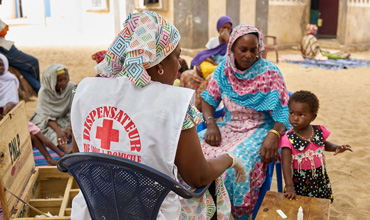Need, Demand and Supply of Health Care in Regards to Growing Emerging and Reemerging Diseases in Sub-Saharan Africa

Abstract:
Need in relation to health care, has generally been
defined as the amount of medical care that medical experts believe a person
should have to remain or become as healthy as possible, based on a current
medical knowledge. This is
also true for the individual and for the entire community. Thus, if a problem,
a barrier or difficulty continues to exist on the path to accession to a higher
level of health, the need exists. In “The
definition and identification of need for health care[1],”
Acheson stated that there exist four phenomena underlying health needs
including: - the risk of pain and illness (in the sense of discomfort, or
"malaise") - the risk of sickness - the inadequacy and deficiency -
the mortality risk. Finally, although certain health needs are expressed, they
do not correspond to real needs. This would provide different areas related to
health interventions, including:
· The ideal
zone (a need corresponds to an expressed demand and adequate health action);
· The area of
non-use (a health action not corresponding to any demand);
· Non-use
of family planning services in both high population growth areas but also high
poverty
· The waste
area (a health action corresponding to a demand but with no corresponding
need);
· The prescription
of laboratory tests and other unnecessary medical procedures in response to
public solicitation, especially persons holding health insurance
· The
discontent area (a demand triggered by a real need, but to which no health
action is taken);
· The recurrence of malaria cases in one region, and the desire by local residents, to have currently non-existent measures, to be taken by health and government authorities, on the environmental and sanitation plan.
References:
[1]. Accorsi, S., Kedir,
N., Farese, P., Dhaba, S., Racalbuto, V., Seifu, A., & Manenti, F. (2009a).
Poverty, inequality and health: the challenge of the double burden of disease
in a non-profit hospital in rural Ethiopia. Transactions
of the Royal Society of Tropical Medicine and Hygiene, 103(5), 461‑468. https://doi.org/10.1016/j.trstmh.2008.11.027
[2]. Acheson, R. M. (1978). The definition
and identification of need for health care. Journal
of Epidemiology and Community Health, 32(1),
10‑15.
[3]. Ahorlu, C. K., Koka, E., Yeboah-Manu,
D., Lamptey, I., & Ampadu, E. (2013). Enhancing Buruli ulcer control in
Ghana through social interventions: a case study from the Obom sub-district. BMC Public Health, 13, 59. https://doi.org/10.1186/1471-2458-13-59
[4]. Ansumana, R., Jacobsen, K. H., Leski,
T. A., Covington, A. L., Bangura, U., Hodges, M. H., … Stenger, D. A. (2013).
Reemergence of chikungunya virus in Bo, Sierra Leone. Emerging Infectious Diseases, 19(7), 1108‑1110. https://doi.org/10.3201/eid1907.121563
[5]. Burgess, P. I., Msukwa, G., &
Beare, N. A. V. (2013). Diabetic retinopathy in sub-Saharan Africa: meeting the
challenges of an emerging epidemic. BMC
Medicine, 11, 157. https://doi.org/10.1186/1741-7015-11-157
[6]. Gopalan, S. S., Mutasa, R., Friedman,
J., & Das, A. (2014). Health sector demand-side financial incentives in
low- and middle-income countries: a systematic review on demand- and
supply-side effects. Social
Science & Medicine (1982), 100,
72‑83. https://doi.org/10.1016/j.socscimed.2013.10.030
[7]. Hotez, P. J., & Kamath, A.
(2009). Neglected Tropical Diseases in Sub-Saharan Africa: Review of Their
Prevalence, Distribution, and Disease Burden. PLOS
Negl Trop Dis, 3(8),
e412. https://doi.org/10.1371/journal.pntd.0000412
[8]. Kivuti-Bitok, L. W., Pokhariyal, G.
P., Abdul, R., & McDonnell, G. (2013). An exploration of opportunities and
challenges facing cervical cancer managers in Kenya. BMC Research Notes, 6, 136. https://doi.org/10.1186/1756-0500-6-136
[9]. Maponga, C. C., Ma, Q., Slish, J. C.,
& Morse, G. D. (2007). HIV pharmacotherapy issues, challenges, and
priorities in sub-Saharan African countries. Topics
in HIV Medicine: A Publication of the International AIDS Society, USA, 15(3), 104‑110.
[10]. Morse, S. S. (1995). Factors in the
emergence of infectious diseases. Emerging
Infectious Diseases, 1(1),
7‑15.
[11]. Moutou, F., & Pastoret, P.-P.
(2015). Defining an emerging
disease. Revue Scientifique Et
Technique (International Office of Epizootics), 34(1), 41‑52.
[12]. Mukadi, Y. D., Maher, D., &
Harries, A. (s. d.). Tuberculosis case fatality rates in high HIV
prevalence popu... : AIDS. Consulté
25 septembre 2016, à l’adresse http://journals.lww.com/aidsonline/Fulltext/2001/01260/Tuberculosis_case_fatality_rates_in_high_HIV.2.aspx
[13]. Nguku, P., Oyemakinde, A., Sabitu,
K., Olayinka, A., Ajayi, I., Fawole, O., … Nasidi,
A. (2014). Training and service in public health, Nigeria Field Epidemiology
and Laboratory Training, 2008 - 2014. The
Pan African Medical Journal, 18
Suppl 1, 2. https://doi.org/10.11694/pamj.supp.2014.18.1.4930
[14]. Noubiap, J. J. N., Jingi, A. M.,
& Kengne, A. P. (2014). Local
innovation for improving primary care cardiology in resource-limited African
settings: an insight on the Cardio Pad(®) project in Cameroon. Cardiovascular Diagnosis and
Therapy, 4(5), 397‑400. https://doi.org/10.3978/j.issn.2223-3652.2014.10.01
[15]. Olmsted, S. S., Moore, M., Meili, R.
C., Duber, H. C., Wasserman, J., Sama, P., … Hilborne, L. H. (2010).
Strengthening laboratory systems in resource-limited settings. American Journal of Clinical
Pathology, 134(3), 374‑380. https://doi.org/10.1309/AJCPDQOSB7QR5GLR
[16]. Omondi Aduda, D. S., & Mkhize,
N. (2014). Ethical issues
evolving from patients’ perspectives on compulsory screening for syphilis and
voluntary screening for cervical cancer in Kenya. BMC Medical Ethics, 15, 27. https://doi.org/10.1186/1472-6939-15-27
[17]. Prentice, A. M. (2006). The emerging
epidemic of obesity in developing countries. International
Journal of Epidemiology, 35(1),
93‑99. https://doi.org/10.1093/ije/dyi272
[18]. Roux, V., & Raoult, D. (1999).
Body lice as tools for diagnosis and surveillance of reemerging diseases. Journal of Clinical Microbiology, 37(3), 596‑599.
[19]. Selman, L., Higginson, I. J.,
Agupio, G., Dinat, N., Downing, J., Gwyther, L., … Harding, R. (2009). Meeting
information needs of patients with incurable progressive disease and their
families in South Africa and Uganda: multicentre qualitative study. BMJ (Clinical Research Ed.), 338, b1326.
[20]. Silva-Matos, C., & Beran, D. (2012). Non-communicable diseases in Mozambique: risk factors, burden, response and outcomes to date. Globalization and Health, 8, 37. https://doi.org/10.1186/1744-8603-8-37
[21].Unwin, N., Setel, P., Rashid, S., Mugusi, F., Mbanya, J.-C., Kitange, H., … Alberti, K. G. M. M. (2001). Noncommunicable diseases in sub-Saharan Africa: where do they feature in the health research agenda? Bulletin of the World Health Organization, 79(10), 947‑953. https://doi.org/10.1590/S0042-96862001001000008

